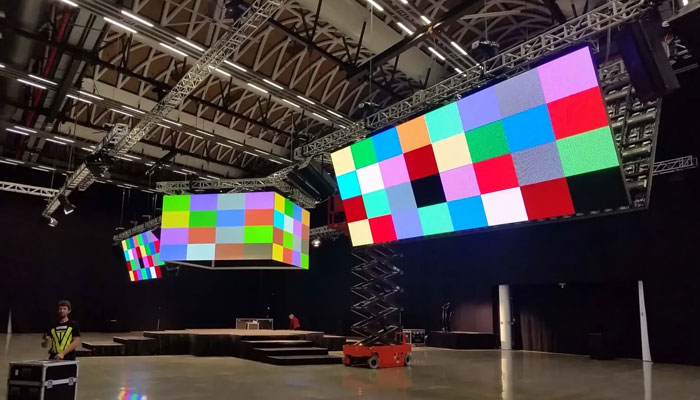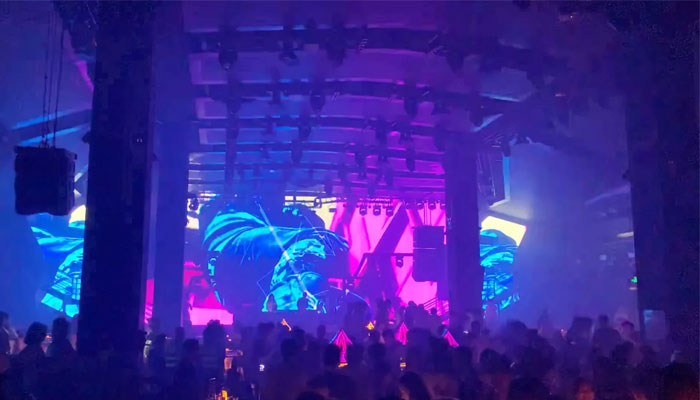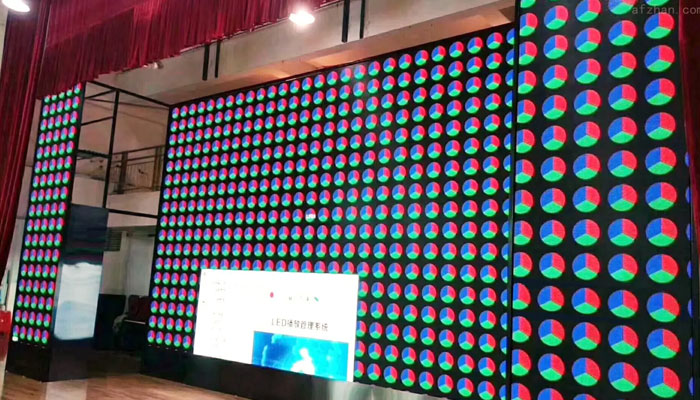Since August 2016, the popularity of the LED display rental screen market has begun to emerge. At that time, judging from the market’s reaction: orders in the outdoor and indoor fixed-installation markets generally declined, while orders from companies that mainly focus on the rental market received soft orders and were in full swing. At the same time, there are also many people in the industry who are very optimistic about the leasing market and believe that the leasing market is a major trend in the development of the industry.
LED display rental market development
The LED display rental market, as a pillar market that is different from the fixed installation, has attracted a large number of display companies in recent years due to the low entry threshold, resulting in fierce market competition. Moreover, due to the implementation of energy-saving and thrifty policies in my country in recent years, the budget for large-scale events has been significantly reduced, and the demand for rental products in the performing arts stage closely related to LED rental displays has been greatly reduced, resulting in a downturn in the LED display rental screen market. However, since the beginning of this year, the rental market has recovered significantly, and the “championship” for the rental market has been staged again, and the rental products of various display companies have been continuously introduced. Under the guidance of small spacing, the development of rental screens is showing great vitality, and the rental market is unprecedentedly prosperous.

The development of my country’s LED display industry rental market can be traced back to the beginning of 2000, when a group of audio and video equipment rental service companies represented by Biruide (Bairui De), Huelead (Huaida) and Dooyle (Dongyang) took the lead. Entered the rental screen market. Subsequently, under the influence of market demand and policies, the development of the LED display rental market is the same as that of the fixed installation market. From small to large, it has gradually developed into one of the most important market segments in the LED display industry. Since the rise of the LED rental screen market, it can be roughly summarized into four stages: 2002-2006 is the initial stage, 2007-2010 is the period of rapid development of rental screens, the rental market is stable in 2011, and the rental industry has been in competition since 2012 the most intense stage.
In the process of the development of the LED display industry, although the rental market and the fixed installation market are not mutually exclusive, to a certain extent, due to the influence of technology, technology, policies, market drivers and other factors, fixed installation and rental The market also affects each other to a certain extent. For example, when the competition in the fixed-installation market is fierce and the profits of display companies continue to decline, the relatively high-profit rental market and its rapidly growing market demand will attract some companies specializing in the production of fixed-installation display screens to actively participate. into the rental market.
When the LED display rental market in my country started, because the display was restricted by technology and craftsmanship, the development was very slow, and there were not many companies involved. On a large scale, the development of my country’s rental screen market has always followed the development of the entire LED industry. In the initial stage, from the technical point of view of the LED rental screen, a single box weighs hundreds of kilograms and is ten centimeters thick. Such a bulky product , which is obviously not conducive to the promotion of the market, and can be said to be a major “hard injury” for rental products. With the advancement of technology, LED display products have made great progress in terms of installation, structure and material, and the flaws of rental products have disappeared, thus laying a solid foundation for opening up the market.
With the rise of the LED rental market, LED rental displays are widely used in large-scale theatrical performances (such as Spring Festival Gala), major sports events (such as the 2008 Beijing Olympics), National Day military parades, large-scale exhibitions and other occasions. In recent years, with the development of my country’s economy, people’s living standards have generally improved, various theatrical performances have flourished in my country, and various TV entertainment programs have emerged one after another, which has greatly promoted the prosperity and development of the LED display rental market.
With the continuous expansion of the rental market, more display companies have been attracted, and many LED display manufacturers have participated in the competition in this market. For the market, price is always the most sensitive weapon to touch consumers’ nerves. Due to the influx of enterprises into the rental market, the price of rental screens has dropped sharply, and the competition in the rental industry has become fierce.
In 2012, the price war in the rental screen market was a sensation. On June 27, 2012, jyled held a grand press conference for rental customers in Shenzhen, and announced the price reduction measures for P2.9 rental screens on the same day. Two days later, on June 29, Lianjian and Guangxiang also launched preferential policies for related products. The price cuts of the two listed companies have triggered a chain reaction like a blockbuster. Four days later, on July 4, jyled also announced price reductions for rental products. The price reductions of several major companies can be said to have officially opened the prelude to the “price war” in the LED display rental market. Since then, the LED display rental market has entered the era of the most intense price competition.
Usually, the large-scale theatrical performance market is an important stage for rental screens to show their talents. However, in August 2013, five ministries and commissions including the Central Propaganda Department jointly issued a notice in August 2013 in response to the excessive and inappropriate performances of theatrical performances, the organizers blindly pursuing big scenes, big stage beauty, big productions, extravagance and waste, and competition. , demanded to stop extravagance and advocate frugal hosting of the party.
Under the environment that the country advocates “diligence and thrift” and builds an “economical” society, the LED display rental market has also undergone great changes. The rental market has gradually expanded from high-end occasions to mid- and low-end. In other words, LED rental displays have begun to fully enter the civilian market. With the expansion of the market, rental products have also continued to innovate and develop with the needs of the market, showing a prosperous situation where a hundred schools of thought contend, and the rental screen market has almost become a “strife” for my country’s LED display companies.
Looking at the development trajectory of my country’s LED display rental market, we will find that the rental screen market has developed rapidly. In addition to benefiting from the advancement of technology, market demand, and policies have an obvious guiding role in the market. At present, with the outbreak of “small spacing” in my country’s LED display industry, the market growth is stable. With the advancement of technology and the overall positive trend and environment, the rental market is yearning for the development of a larger and broader space. At the same time, as the industry has entered a period of “diversified” development, display products have become more abundant and diverse, and enterprises have developed across multiple fields, which has brought a very profound impact on the LED rental screen market.
Mr. Wang Zheng, who is known as the “Leasing King” in the conference and exhibition service industry, said in an exclusive interview with the exhibition media that starting from 2018, the P4 screen will gradually withdraw from the indoor LED screen rental market, while the P3 screen rental business has become mainstream. In the foreseeable 3 years, the P2 screen will also be fully rolled out in the first-line exhibition destinations in Beijing, Shanghai, Guangzhou and Shenzhen.
One of the most significant changes in the LED rental screen is the “dot pitch”. As people’s demand for high-definition displays is getting higher and higher, thanks to the advancement of LED display technology, manufacturing process and material level, the dot pitch of rental products is also shrinking with the times. From 2008 to 2012, P10 and P16 full-color outdoor display screens were the mainstream products in the rental market, covering 70% of the market share of outdoor LED screens. A qualitative leap, especially the P10 full-color LED display accounts for almost 80% of the market. In 2013, P4.8 rental products first appeared in the industry. Today, outdoor rental screens have developed to P3-P5, and there is a trend toward P2.0.
Today, when the P0.8 small-pitch display screen can be mass-produced, the pace of rental products moving towards a smaller pitch seems to be the general trend and the inevitable development of the rental market.
In addition to the development of high-definition rental products, another notable feature is diversity and humanization. The so-called diversity is mainly reflected in the field of LED special-shaped screen and transparent screen. In recent years, many companies in the industry engaged in the production of special-shaped modules and transparent screens have an increasingly huge impact on the rental market. Many special-shaped screen and transparent screen manufacturers, such as Mingxingguang and Yipin Optoelectronics, have launched their own rental products, which greatly enriches the rental market and gives consumers more choices. Humanization is mainly reflected in the change of the rental product itself. Compared with the rental products of the past, today’s rental products have undergone earth-shaking changes in terms of appearance design and practicality. The emergence of new materials such as carbon fiber, magnesium alloy, and nano-polymer has completely changed the rental products and played an extremely important role in promoting the development of the rental market.
At present, a “qualified” rental product basically has the characteristics of “quick installation and disassembly, quick inspection, and light and thin box”.
In 2017, the outbreak of small spacing drove the development of the entire LED display industry, and its impact on the rental market also began to emerge. As early as a year or two ago, the possibility of small-pitch entering the rental market caused discussions in the industry, but due to the constraints of technology, craftsmanship and market demand, real small-pitch rental products have not yet appeared in the market. . However, with the demand for high-definition displays in video conferences, boutique conferences and other occasions, small-pitch rentals have begun to enter people’s field of vision.
As the author of this article has previously stated, rental products are starting to move towards the P2 mark. At present, some companies in the industry have tried the research and development of P2.0 rental products, and some companies have mass-produced P2.6 high-definition rental products. Regarding the small-pitch leasing market, industry insiders predict that the global small-pitch leasing market may reach an output value of tens of billions in the future.
In recent years, due to the fierce competition in the domestic market, more and more display companies have gone overseas, and LED rental screens are the “magic weapon” for Chinese display companies to open up the market. Different from the domestic market, overseas market customers, especially European and American leasing companies, have higher requirements on the appearance details and quality of products than the domestic market. Compared with domestic prices, they pay more attention to factors such as brand. At present, in the European and American markets, the main customers of LED rental screens are some large end users, such as rental companies, film and television companies, etc., and many companies in the industry, such as Unilumin Technology, Bairui De, Dongyang Technology, Qipuguang, and Vision Light. Xu et al. have already launched a fierce market competition in the mid-to-high-end rental market. In order to compete for the overseas rental market, the high-end rental products of domestic companies frequently appear in various overseas exhibitions. However, in all display-related exhibitions, there is no shortage of Chinese display companies, and there will be no shortage of rental screens that play the role of “pioneering” in developing overseas markets. .
At present, in addition to the European and American markets, emerging markets in Southeast Asia also have a strong demand for rental screens. The Indian and Russian markets are also the main battlefields for domestic companies to compete. Under the circumstance that the domestic market has been “red with a bayonet” for many years, the promising overseas rental market is very attractive to Chinese rental screen companies.
For display companies engaged in rental screen production, this is the best of times and the worst of times. Fortunately, any display company can get a “share” in the rental market, but the competition in the market is too fierce. After all, after so many years of development, a group of professional display rental manufacturers represented by Lei Ling and Gloshine have been born in the LED display rental industry. They have a huge influence in the display rental industry and are well received by consumers. Welcome, feel like a duck to water in the rental market. At the same time, various listed display companies in the industry, such as Absen, Leyard, Unilumin, etc., are also making rental products and occupy a large market share in this market. For the vast majority of small and medium-sized display companies, this market, which seems to be more profitable than fixed installations and continues to grow in market size, is not as “easy” as imagined. Disorderly competition, policy changes, lease customer payment cycle, raw material, labor prices and many other factors have a significant impact on enterprises.
On the whole, there are many display companies in the industry that produce rental products, but few can really make the products well. The reason is that rental products need to be repeatedly installed, disassembled and transported during use. Compared with fixed screens, they have higher requirements on product appearance design, quality and reliability.
The scale of the LED rental screen market is huge, and the future development prospects are immeasurable. For a long time, various video conferences, large-scale opening ceremonies, wedding ceremonies, signing ceremonies, opening ceremonies, star performances, product recommendations, hotel rentals and other activities have been the main markets for rental screens, and the scale is very large. Calculated in the field of stage art, the global LED stage market has reached US$740 million this year, a year-on-year increase of 14%. The growth rate is expected to slow slightly in the next few years, but it will still maintain a growth trend. By 2020, it is expected to grow to $1 billion.
The pie in the rental market is so huge, and the entry threshold is not too high, and fierce competition will be a long-term trend. After more than ten years of development, the LED rental display screen has matured in terms of technology, craftsmanship, and third-party supporting systems. The rental market is developing towards product specification standardization, high-definition display, and intelligent interaction.
Different from the fixed screen, the customers of the LED rental screen are mostly renters, and the purchase of the display screen is not a consumption, but an investment method. The lessor collects rent by renting out the display screen, recovers the cost, and then makes a profit. Therefore, for rental screen manufacturers, in order to save costs and create greater value for customers, “multiple uses for one screen” may become one of the important development directions of display rental products in the future.
At the same time, with the global “artificial intelligence” in the ascendant, the construction of “smart city” in full swing, and the continuous surge of various new technologies and new energy, LED displays are also facing greater innovation and application space, and intelligence is becoming an industry. one of the major trends in development. For the LED rental screen, it will no longer be limited to the simple display function, and the development of intelligent and interactive will be more easily favored by the market.
As the LED rental market expands to a wider area, it will also become another trend for LED rental screen manufacturers to develop different products for various application fields. Therefore, in the future, the combination of LED rental screens and third-party display devices to form an interactive development model may also become a reality.
It is foreseeable that products in the future LED display rental market will become more and more standardized and standardized. The LED display screen is still mainly customized, but in terms of “standardization”, the industry has gradually formed some “standards”, such as the development of cabinets. In the industry, in the past, the cabinets of rental screens were not only bulky and bulky, but also had different specifications. There were 500800, 5001000, but now 500*500 has developed into the mainstream of rental products.




